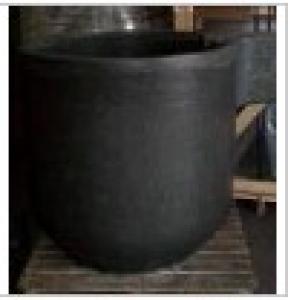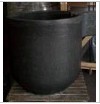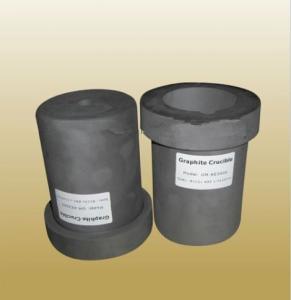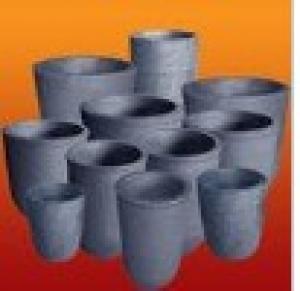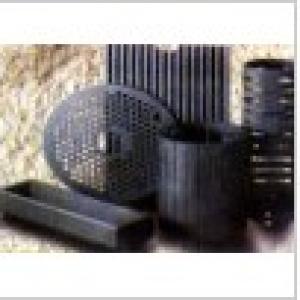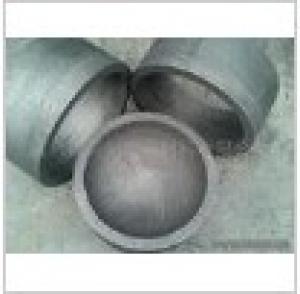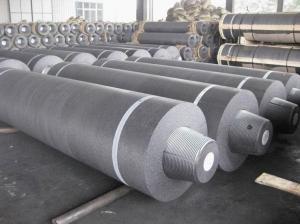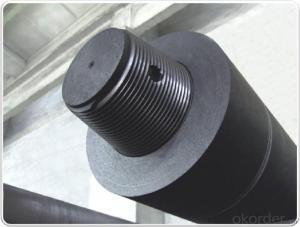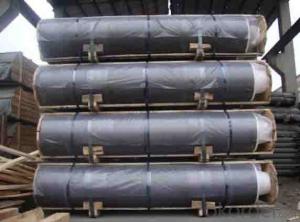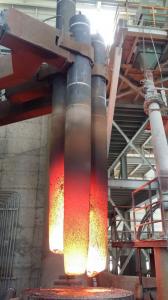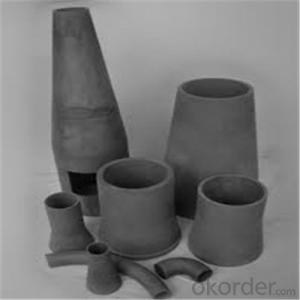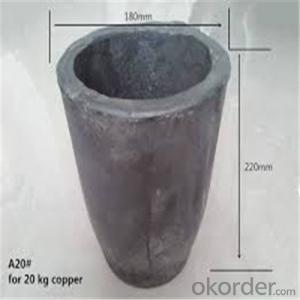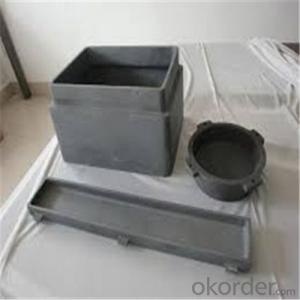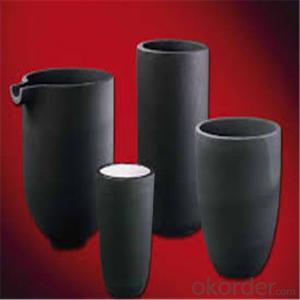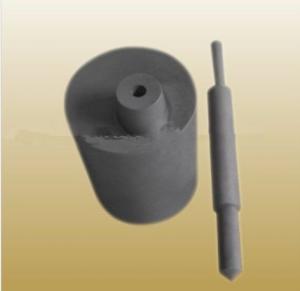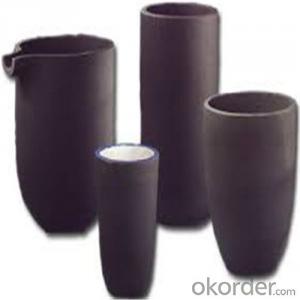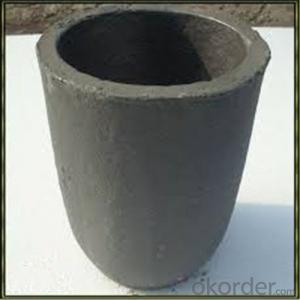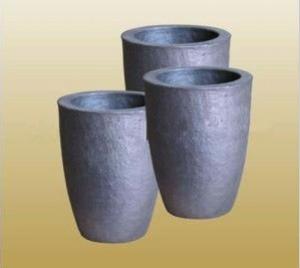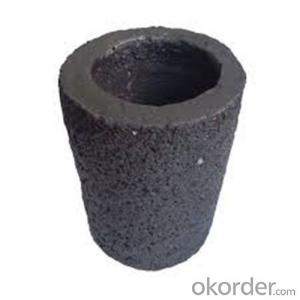Special Graphite Crucible for Aluminum Products
- Loading Port:
- China Main Port
- Payment Terms:
- TT or LC
- Min Order Qty:
- 50 Sets set
- Supply Capability:
- 3000 Sets per Month set/month
OKorder Service Pledge
Quality Product, Order Online Tracking, Timely Delivery
OKorder Financial Service
Credit Rating, Credit Services, Credit Purchasing
You Might Also Like
Detailed Product Description
Special Shaped Graphite products are used in various industrails,including graphite crucible and graphite seal
Special Shaped Graphite products are used in various industrails.it can be used as sealing in machinery as carbon graphite material, such as the quiet ring or the moving ring, doctorblade, piston-ring, sealing expansionring and the raw materias.
- Q: How is a graphite crucible manufactured?
- A graphite crucible is typically manufactured using a process called isostatic pressing. Isostatic pressing involves placing graphite powder into a mold and subjecting it to high pressure from all directions. This process ensures that the graphite particles are evenly compacted, resulting in a dense and homogeneous crucible. The first step in manufacturing a graphite crucible is to select the appropriate graphite material. High-quality graphite with a low ash content is typically chosen for its excellent thermal conductivity, high temperature resistance, and chemical stability. The graphite is then milled into a fine powder to ensure a consistent particle size. Next, the graphite powder is poured into a flexible rubber mold. The rubber mold is designed to withstand the high pressure that will be applied during the isostatic pressing process. The mold is carefully sealed to prevent any leakage of graphite powder. The sealed mold is then placed into a high-pressure vessel. Hydraulic pressure is applied from all directions, exerting uniform pressure on the graphite powder. This pressure compacts the graphite particles, eliminating any voids or porosity that may be present. The high pressure also helps to align the graphite particles, resulting in improved mechanical properties. Once the pressing process is complete, the mold is removed, leaving behind a green crucible. The green crucible is then subjected to a baking process called carbonization. During carbonization, the crucible is heated to temperatures of around 3000 degrees Celsius in an inert atmosphere. This process removes any volatile materials and further strengthens the crucible. After carbonization, the crucible undergoes a final machining process to achieve the desired dimensions and smooth surface finish. This may involve precision grinding, turning, or milling to ensure the crucible meets the required specifications. In conclusion, a graphite crucible is manufactured through a process called isostatic pressing, which involves compacting graphite powder under high pressure. This process, along with subsequent carbonization and machining, ensures the crucible has excellent thermal conductivity, high temperature resistance, and chemical stability.
- Q: Are there any specific cleaning agents or methods recommended for graphite crucibles?
- Yes, there are specific cleaning agents and methods recommended for graphite crucibles. Graphite crucibles should be cleaned using a mixture of water and potassium nitrate or hydrochloric acid. The crucible should be soaked in this solution for a specific duration and then rinsed thoroughly with water. Additionally, a soft brush can be used to remove any stubborn residue. It is important to follow the manufacturer's guidelines and safety precautions while cleaning graphite crucibles.
- Q: The biggest problem with graphite crucibles must be to use in a vacuum or a reducing atmosphere
- Reducing atmosphere is in such as crucible with coke and he is using a principle that because the air has been burning up!
- Q: When decomposing iron ore, why should it be carried out at low temperature?
- At present, it is more common to use alkali fusion to decompose sample. Sodium carbonate, sodium hydroxide, sodium hydroxide, potassium hydroxide and sodium hydroxide and sodium carbonate with commonly used fluxes (2:1) mixed flux etc.. The melting can be carried out in a silver crucible, a Nickel Crucible, a high aluminium crucible or a graphite crucible. Also useful sodium peroxide in the Nickel Crucible semi molten.Since iron ore contains a large amount of iron, it can be damaged by melting directly in the platinum crucible with sodium carbonate, and platinum also affects the determination of iron, so it is seldom used.For iron ores containing sulfides and organic compounds, the sample should be burned at 500-600 degrees C to remove sulfur and organic matter, and then decomposed with hydrochloric acid and added a small amount of nitric acid to decompose the sample completely. The presence of nitric acid affects the determination of iron and can be removed by evaporation with hydrochloric acid.
- Q: Can a graphite crucible be used for ceramic coating applications?
- No, a graphite crucible cannot be used for ceramic coating applications. Graphite is a highly conductive material and can react with certain chemicals used in ceramic coating processes, resulting in contamination of the coating material. Additionally, graphite has a relatively low melting point compared to ceramic coating temperatures, which may cause the crucible to degrade or fail during the coating process. It is recommended to use crucibles made of materials specifically designed for ceramic coating applications, such as alumina or silica. These materials have higher melting points and are chemically inert, ensuring the integrity of the ceramic coating process.
- Q: Is it possible to achieve controlled pouring with a graphite crucible?
- Yes, it is possible to achieve controlled pouring with a graphite crucible. Graphite crucibles are widely used in various industries, including metal casting and melting, due to their unique properties. Graphite has a high melting point, excellent thermal conductivity, and good resistance to thermal shock, making it suitable for handling high-temperature materials. To achieve controlled pouring with a graphite crucible, several factors need to be considered. Firstly, the crucible should be properly preheated to the desired pouring temperature. This ensures that the molten material remains at the desired temperature during pouring, preventing premature solidification. Secondly, the design of the crucible and its pouring lip should allow for precise control over the flow of the molten material. The pouring lip can be shaped to achieve a steady and controlled stream, reducing the risk of splashing or spilling. Furthermore, the operator's skill and experience play a crucial role in achieving controlled pouring. They need to have a good understanding of the material being poured, its characteristics, and the appropriate pouring techniques. They should also be aware of any potential hazards and take necessary precautions to ensure safety during the pouring process. In summary, while achieving controlled pouring with a graphite crucible is possible, it requires proper preheating, appropriate crucible design, and skilled operators. By considering these factors, it is possible to achieve precise and controlled pouring for various applications.
- Q: Can graphite crucibles be used for melting pharmaceutical compounds?
- Yes, graphite crucibles can be used for melting pharmaceutical compounds. Graphite crucibles are known for their high melting point, which makes them suitable for high-temperature applications such as melting metals, alloys, and even certain chemicals. Since pharmaceutical compounds can have different melting points, it is important to ensure that the temperature range of the graphite crucible is compatible with the melting point of the specific compound being melted. Additionally, graphite crucibles are chemically inert and have low reactivity, which reduces the risk of contamination or chemical reactions with the pharmaceutical compounds during the melting process. However, it is essential to consider the specific requirements and properties of the pharmaceutical compound being melted to ensure compatibility with the graphite crucible.
- Q: Single crystal furnace quartz crucible cast 22 inch 175 kilograms of feed it
- We're doing this experiment, and tomorrow we'll start crushing and using the crucible
- Q: How do you determine the appropriate crucible material for a specific application?
- To determine the appropriate crucible material for a specific application, several factors need to be considered. Firstly, it is important to evaluate the temperature range of the application. Different crucible materials have different temperature limitations. For high-temperature applications, materials such as graphite or refractory metals like tungsten or molybdenum may be suitable, while for lower temperature applications, materials like porcelain or alumina may be sufficient. Secondly, the chemical compatibility of the crucible material with the substances being used in the application needs to be assessed. Certain materials may react with specific chemicals or gases, leading to contamination or degradation of the crucible. It is crucial to select a material that is chemically inert or resistant to the substances being used. Thirdly, the thermal conductivity and thermal shock resistance of the crucible material should be taken into account. Some applications require rapid heating and cooling cycles, which can cause thermal stress on the crucible. Materials with high thermal shock resistance, such as quartz or boron nitride, may be more suitable in such cases. Moreover, the mechanical strength and durability of the crucible material should be considered. Some applications involve mechanical forces, stirring, or pouring of molten materials, which can subject the crucible to physical stress. Materials like silicon carbide or stainless steel offer good mechanical strength and can withstand such conditions. Lastly, the cost and availability of the crucible material should be considered. Some materials, such as platinum or iridium, may offer excellent performance but can be expensive and difficult to procure. It is important to strike a balance between performance and cost-effectiveness. In conclusion, determining the appropriate crucible material for a specific application requires considering factors such as temperature range, chemical compatibility, thermal conductivity and shock resistance, mechanical strength, and cost. By carefully evaluating these factors, one can select a crucible material that will meet the requirements of the application effectively.
- Q: Can graphite crucibles be used for melting rare earth metals?
- Melting rare earth metals is possible using graphite crucibles. Graphite possesses desirable qualities like a high melting point, excellent thermal conductivity, and resistance to chemical reactions. These properties make graphite an ideal material for applications that involve high temperatures, such as melting rare earth metals. Moreover, graphite crucibles are durable and can endure the harsh conditions associated with molten metals. This makes them a suitable choice for the melting and refining of rare earth metals. Nevertheless, it is crucial to acknowledge that certain rare earth metals, like cerium, can react with graphite when exposed to high temperatures. This can lead to the formation of carbonates. Hence, it is advisable to carefully consider the specific properties and reactivity of each rare earth metal before employing graphite crucibles for the purpose of melting.
Our products are sold all over the country, and exported to America, Germany, Spain, India, Japan and Korea. Besides, we have strict management and advanced production technology.
We promise we will win more clients and a larger market with honest commercial credit, high quality of products, competitive price and good service.
1. Manufacturer Overview
| Location | Inner Mongolia,China (Mainland) |
| Year Established | 2006 |
| Annual Output Value | US$2.5 Million - US$5 Million |
| Main Markets | 7.14% North America 7.14% South America 7.14% Eastern Europe 7.14% Southeast Asia 7.14% Africa 7.14% Oceania 7.14% Mid East 7.14% Eastern Asia 7.14% Western Europe 7.14% Central America 7.14% Northern Europe 7.14% Southern Europe 7.14% South Asia 7.14% Domestic Market |
| Company Certifications |
2. Manufacturer Certificates
| a) Certification Name | |
| Range | |
| Reference | |
| Validity Period |
3. Manufacturer Capability
| a) Trade Capacity | |
| Nearest Port | Xingang,Tianjin |
| Export Percentage | 31% - 40% |
| No.of Employees in Trade Department | 21-50 People |
| Language Spoken: | English, Chinese |
| b) Factory Information | |
| Factory Size: | 1,000-3,000 square meters |
| No. of Production Lines | 7 |
| Contract Manufacturing | 1,000-3,000 square meters |
| Product Price Range | Low and/or Average |
Send your message to us
Special Graphite Crucible for Aluminum Products
- Loading Port:
- China Main Port
- Payment Terms:
- TT or LC
- Min Order Qty:
- 50 Sets set
- Supply Capability:
- 3000 Sets per Month set/month
OKorder Service Pledge
Quality Product, Order Online Tracking, Timely Delivery
OKorder Financial Service
Credit Rating, Credit Services, Credit Purchasing
Similar products
Hot products
Hot Searches
Related keywords
